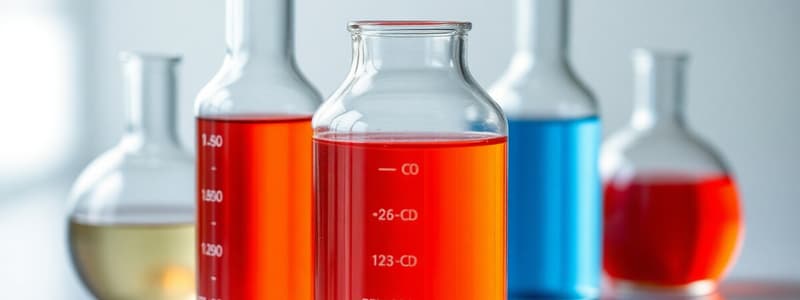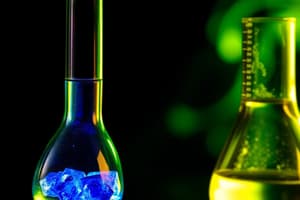Podcast
Questions and Answers
What characterizes an endothermic reaction?
What characterizes an endothermic reaction?
- The enthalpy change is negative.
- Heat is absorbed from the surroundings. (correct)
- Bond energies are always greater than bond dissociation energies.
- Heat is released to the surroundings.
Which reaction has the highest enthalpy change based on the provided examples?
Which reaction has the highest enthalpy change based on the provided examples?
- N₂(g) + O₂(g) → 2NO(g) ΔH° = +180.5 kJ (correct)
- C(s) + H₂O(g) → CO(g) + H₂(g) ΔH° = +131.4 kJ
- H₂(g) + O₂(g) → H₂O(l) ΔH° = -285.8 kJ
- H₂(g) + I₂(g) → 2HI(g) ΔH° = +53.8 kJ
What is the relationship between bond energy and bond dissociation energy?
What is the relationship between bond energy and bond dissociation energy?
- Bond energy is always greater than bond dissociation energy.
- Bond dissociation energy is related to forming bonds.
- Bond dissociation energy requires energy to break bonds. (correct)
- There is no relationship between the two.
How is the standard enthalpy change, ΔH°, defined?
How is the standard enthalpy change, ΔH°, defined?
What determines whether a reaction absorbs or releases energy?
What determines whether a reaction absorbs or releases energy?
Flashcards
Endothermic reaction
Endothermic reaction
A chemical reaction that absorbs heat from its surroundings.
Enthalpy of Reaction
Enthalpy of Reaction
The amount of heat absorbed or released during a chemical reaction.
Standard Enthalpy Change (ΔH°)
Standard Enthalpy Change (ΔH°)
The enthalpy change measured at standard conditions (25°C, 1 atm).
Bond Dissociation Energy
Bond Dissociation Energy
Signup and view all the flashcards
Bond Energy
Bond Energy
Signup and view all the flashcards
Study Notes
Endothermic Reactions
- Endothermic reactions absorb heat from the surroundings
- Heat is transferred from the surroundings to the system
- Examples include the decomposition of limestone, the sublimation of dry ice, and the freezing of water
Exothermic Reactions
- Exothermic reactions release heat into the surroundings
- Heat is transferred from the system to the surroundings
- Examples include the combustion of methane and the freezing of water
Enthalpy of Reaction
- Enthalpy of reaction is the amount of heat absorbed or released during a chemical reaction
- Measured at 25°C (or 298K) and one atmospheric pressure
- Negative for exothermic reactions
- Positive for endothermic reactions
Bond Energy
- Breaking bonds requires energy
- Forming bonds releases energy
- Bond dissociation energy = energy to break one mole of a particular bond
- Bond energy = energy released when forming one mole of a bond
Enthalpy Change (ΔH°)
- ΔH° = Sum of bond dissociation energies of reactants - Sum of bond energies of products
- It indicates whether the reaction absorbs or releases energy
Studying That Suits You
Use AI to generate personalized quizzes and flashcards to suit your learning preferences.




